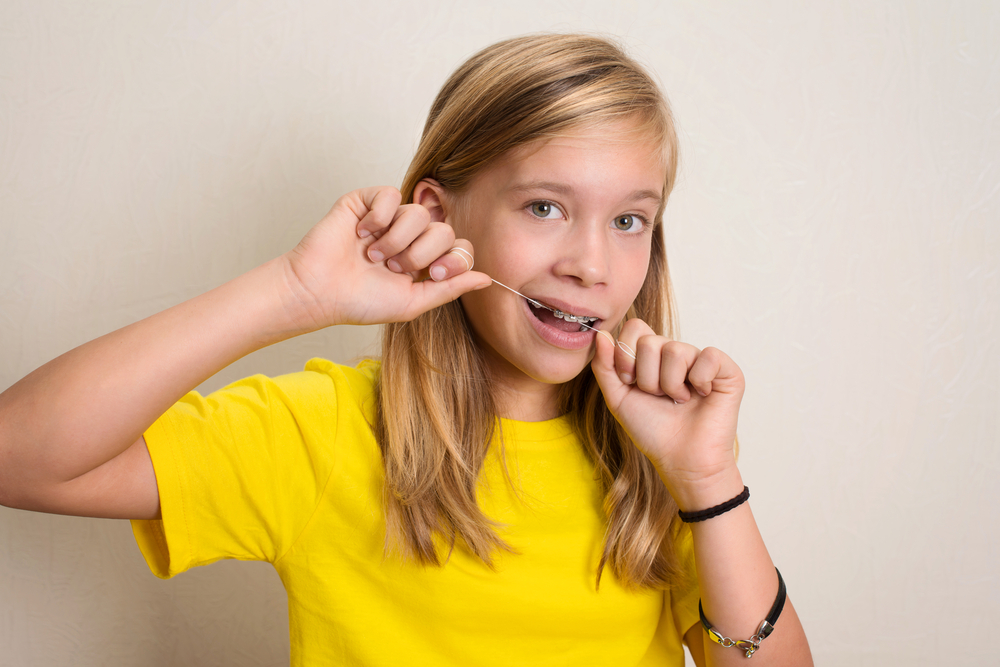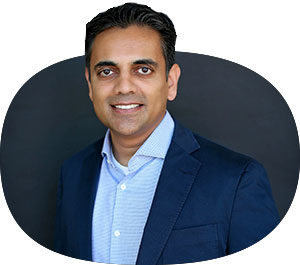
How to Floss With Braces Using 4 Common Flossing Tools
Getting braces means that before you know it, you’ll have a beautifully straight smile you can be proud of. And while your braces work hard to align your teeth, it’s important that you practice excellent oral hygiene so that your teeth move to their ideal spots as efficiently as possible — braces are most effective in a healthy oral environment. Taking good care of your teeth means both a healthy smile and a properly aligned one when your braces come off!
So it goes without saying that your oral hygiene toolkit should start with the basics: a soft toothbrush, fluoride toothpaste, mouthwash, and dental floss. Now, brushing your teeth and rinsing with mouthwash are the same with braces or without, but flossing with braces requires a slightly different approach than usual. Understandably, flossing with braces can seem confusing and tricky at first. But don’t worry, you’re not alone! In Dr. Anand Patel’s 20 years as an orthodontic specialist, how to floss with braces has been one of the top questions asked by new braces patients.
To help you get started, we’ve put together this primer that covers 4 ways to floss with braces — read on and you’ll be a flossing pro in no time!
Table of Contents
Why is Flossing with Braces Important?
If you didn’t floss daily before braces, having braces is a great time to start since there are more nooks and crannies around braces, wires, and between teeth for sugars and food debris to hide. Floss gets into those difficult spaces and cleans where a toothbrush can’t clean as thoroughly. And the often-asked question of whether to floss or brush first? Your Tulsa and Claremore orthodontist suggests flossing before brushing. Studies have shown that cleaning your teeth in this order is more effective than the other way around.
With flossing, you not only get the sticky sugars and bits of food between teeth and around braces but you also help remove plaque build-up between teeth and at the gumline. Neglecting to floss can lead to tooth decay, cavities, or gum disease which can potentially disrupt and prolong your braces treatment. It’s fair to say that most people want to get their braces off sooner than later. In extreme cases, some patients even have to get their braces removed in order to get their dental health issues resolved.
4 Different Tools for Flossing with Braces
Now that you know why flossing with braces is important, let’s talk about 4 key flossing tools that will help make flossing easy, quick, and effective.
1. Dental Floss
If you were in the habit of flossing once a day before you got braces, we’re glad to hear it! However, now that you have braces, you might find yourself flossing a few more times a day, and we recommend using a waxed dental floss if you weren’t using this kind already. Waxed dental floss is preferable over non-waxed when you have braces because unwaxed floss can shred, leaving little threads that can get stuck in your teeth and appliance.
When it comes to waxed dental floss, there’s plenty of variety so take the time to find one that works for you, is comfortable, and is easy to use. Some are flavored with breath-freshening mint or tasty fruit flavors. If you’re a new flosser and experience some tenderness or bleeding from flossing, your team at The Brace Place suggests starting with a dental floss called dental tape until your teeth get used to being flossed. Dental tape — or ribbon tape — is broader and flatter than dental floss and can be a bit gentler on teeth unused to flossing. Dental tape can also be a bit easier to handle.
There’s also the option of Superfloss, a floss by Oral-B that has three styles of floss in one: a stiff floss that makes it easier to insert the floss behind your appliance and clean under it, traditional floss that cleans between teeth and in the gumline, and a wide, spongy section especially designed for cleaning brackets and around wires.
To floss with dental floss, follow these step-by-step flossing instructions for flossing with braces:
- Take an 18” long piece of dental floss.
- Thread one end of the floss between your wire and your teeth.
- Pull the dental floss through and wrap the ends around your index fingers.
- Use firm but comfortable pressure to insert the floss between your teeth. Holding the floss in a “C” shape, floss into your gumline at the base of your tooth as well as flossing the sides of each.
- Pull out the floss and go through steps 2-4 for the next teeth.
- Repeat until you’re done!
2. Using Dental Floss with a Floss Threader
If inserting your dental floss between your wires and teeth seems tricky, a floss threader can help make it easier to position your floss correctly. A floss threader is a small, thin, flexible plastic tool with a large loop on the end of a handle. To use it, thread dental floss through the loop, and if you want to, tie it on.
Insert the handle end of the floss threader in the space between your wire and teeth. Pull the floss threader through that space until it completely passes through and your dental floss is now positioned between your wire and teeth. Floss your teeth into the gumline and along the sides as usual. Pull out the floss. Repeat for the rest of your teeth until you’re done.
3. Orthodontic Flosser
We promise, learning how to floss with braces comes easily with this flossing tool. An orthodontic flosser is a small, plastic tool with two narrow arms that have floss strung tightly between them and a handle for maneuvering the floss. This handy tool makes getting floss behind your archwires a simple and fuss-free motion. Orthodontic flossers also eliminate the need to wind dental floss around your fingers.
With an orthodontic flosser, hold the plastic handle and position the floss where you want to clean between teeth and into the gumline. Slide the floss in between teeth and use a “c” motion to get into the gumline at the base of each tooth. Repeat for all teeth. Now we should mention that most orthodontic flossers are single-use, so if you’re looking for a more environmentally-friendly option, reusable orthodontic flosser handles are available. With these, you thread floss onto them yourself before each flossing session.
Orthodontic flossers are great for on-the-go flossing. Keep some in your purse, car, or backpack to quickly and easily floss your teeth when you’re not at home.
4. Waterpik Water Flosser
An entirely different and very thorough method for cleaning between teeth and around braces is using a water flosser. There’s a reason why orthodontists and dentists spray a directed jet of water at teeth to clean teeth and braces. As an additional step to brushing and daily flossing with dental floss, a water flosser for braces wearers is one of the best floss methods for a deep oral clean.
A water flosser like the Waterpik® sprays a strong, steady blast of water that removes the sugars, food particles, and plaque that has accumulated between teeth, along the gumline, and around brackets and archwires. In fact, one study reports that participants who used a Waterpik® in their oral hygiene routine experienced an almost 75% reduction in overall plaque versus those who only used dental floss.
Using a WaterPik® for cleaning braces and teeth is easy and refreshing:
- Fill the water reservoir with lukewarm water and insert your flosser tip onto the water flosser handle.
- Lean over the sink and close your mouth slightly around the flosser.
- Set your water flosser to low pressure to start. You can turn up the pressure once you get going.
- Turn it on and direct the spray at your gumline, starting with your back teeth and moving towards the front teeth. Spray water both along the outer and inner gumline to ensure you spray around the entire base of each and every tooth and be sure to spray directly at your braces brackets.
- Move on to the next tooth and repeat until you’ve water flossed your entire mouth.
You will find that many of the Waterpik® brand water flosser kits come with a special orthodontic tip shaped especially for cleaning braces, but the regular tip works well too.
On top of floss, a toothbrush, and mouthwash, you can supplement your braces-cleaning toolkit with extra orthodontic tools that make maintaining a healthy smile with braces even easier. Interdental picks or a braces mouthguard are accessories to consider for boosting your oral care routine.
How to Floss with A Permanent Retainer
Once your braces come off, Dr. Patel will prescribe a retainer to help maintain your new smile. Retainers are a typical after-care appliance and are either removable or permanent. If you have a removable retainer, flossing is just like it was before braces. Simply take out your retainer to floss. However, if you have a permanent retainer, flossing requires a technique similar to flossing with braces.
A permanent retainer is a thin wire permanently bonded to the back of teeth (also called the lingual side) and is only removable by your orthodontist. Your wire will either be a single thin wire or a thicker, twisted wire attached with bonding on each tooth or just at the ends. Permanent retainers are more often used on the lower teeth — and typically only for the front 4-6 teeth between the two canine teeth. Flossing well when you have a permanent retainer is similar to how you floss with braces:
- Using a floss threader with dental floss, slide the threader from below the wire (close to the gums) and pass it up above the wire until the threader is clear of the wire.
- Floss into the gumline and between the teeth.
- If your wire is bonded on only two teeth (at each end of the wire), floss from tooth to tooth, from one side to the other.
- If there is bonding on each tooth, repeat the process of inserting the floss threader for positioning the floss correctly and flossing around each tooth.
Sometimes the placement of your permanent retainer’s bonding can make it difficult to pass a floss threader from below the wire. If this is the case for you, a second method for how to floss with a permanent retainer is to pass the entire floss threader with the dental floss attached from the front of your teeth to the lingual side. In either case, since you’re used to flossing with braces, learning how to floss with a permanent retainer quickly becomes second nature!
We Help You Get the Most Out of Your Braces
Ready for a new smile with braces and want to keep your teeth clean and cavity-free during treatment? Contact us today for a free initial consultation and we’ll help you make it happen! At The Brace Place, we believe everyone deserves a confident, healthy smile; your Tulsa and Claremore orthodontist, Dr. Patel, and the entire team at The Brace Place are here to transform your smile comfortably and efficiently.


























